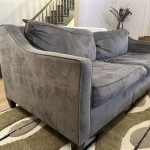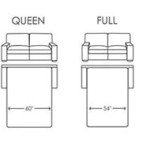How to Pull Out a Hospital Sofa Bed from Home Depot: A Comprehensive Guide
Hospital sofa beds, often purchased from retailers like Home Depot, offer a versatile solution for accommodating guests or providing a temporary sleeping surface in healthcare settings. These beds combine the functionality of a sofa with the comfort of a pull-out bed, making them ideal for maximizing space and offering comfort. Understanding the specific mechanisms involved in deploying these beds is crucial for both users and caregivers. While Home Depot offers various models, the fundamental principles of operation remain consistent across many designs. This article provides a detailed guide on how to properly pull out a hospital sofa bed, covering key steps, common issues, and safety considerations.
Understanding the Sofa Bed Mechanism
Before attempting to pull out the bed, it's essential to familiarize oneself with the basic components and locking mechanisms of the sofa bed. Typically, these sofa beds consist of the main sofa frame, a foldable bed frame concealed within the sofa, a mattress (often foldable), and various hinges and locking mechanisms. The primary locking mechanism usually secures the bed frame within the sofa, preventing accidental deployment during regular use. Identifying the location and type of locking mechanism is the first step in the process. This may involve looking for levers, buttons, or handles on the back or sides of the sofa.
The folding mechanism is also important to understand. Most hospital sofa beds from Home Depot feature a tri-fold or bi-fold bed frame. A tri-fold frame unfolds in three sections, while a bi-fold frame unfolds in two. Understanding how the frame is designed to unfold will help prevent force or damage during the deployment process.
Furthermore, the quality of the mechanism influences the ease of operation. Higher-quality models often feature smoother hinges, stronger locking mechanisms, and more durable frames. Reviewing the product specifications from Home Depot, including warranty information, can provide insights into the expected lifespan and operational characteristics of the sofa bed.
Step-by-Step Instructions for Pulling Out the Bed
The following steps provide a general guide for pulling out a hospital sofa bed from Home Depot. Note that specific models may vary slightly, so always refer to the manufacturer's instructions if available.
Step 1: Remove any Cushions or Obstructions. Before attempting to pull out the bed, remove all cushions, pillows, blankets, or other items from the sofa. This ensures a clear path for the bed frame to unfold and prevents damage to the cushions or the sofa mechanism. Place the cushions aside so they don't obstruct the bed when it's fully extended.
Step 2: Locate and Release the Locking Mechanism. Identify the locking mechanism that secures the bed frame within the sofa. This may be a lever located on the back of the sofa, a button on the side, or a handle underneath the front edge of the sofa. Refer to any provided documentation or labels on the sofa itself for guidance. Once located, carefully disengage the locking mechanism. This usually involves pulling the lever, pressing the button, or lifting the handle.
Step 3: Begin to Pull Out the Bed Frame. With the locking mechanism disengaged, gently begin to pull the bed frame forward. Apply even pressure to both sides of the frame to ensure a smooth and balanced deployment. Avoid using excessive force, as this can damage the hinges or the frame itself. If resistance is encountered, double-check that the locking mechanism is fully disengaged and that there are no obstructions hindering the movement.
Step 4: Unfold the Bed Frame (Tri-Fold or Bi-Fold). As the frame is pulled out, it will begin to unfold. If it's a tri-fold design, the frame will unfold in three sections. A bi-fold design will unfold in two sections. Continue to pull the frame out until it is fully extended and the bed is flat and stable. Ensure that all sections are securely locked into place, if applicable. Some models feature automatic locking mechanisms for each section; others may require manual locking.
Step 5: Prepare the Mattress. Once the bed frame is fully deployed, unfold the mattress. The mattress is typically folded within the sofa along with the bed frame. Unfold the mattress and position it on the bed frame, ensuring it is properly aligned and evenly distributed. Some hospital sofa bed mattresses are made of multiple sections that need to be arranged correctly. Check for any straps or fasteners that secure the mattress sections together and ensure they are properly connected.
Step 6: Inspect for Stability and Safety. Before using the bed, carefully inspect it for stability and safety. Ensure that the bed frame is securely locked in place and that the mattress is properly positioned. Check for any loose hinges, damaged sections, or sharp edges that could pose a hazard. If any issues are identified, address them before allowing anyone to use the bed. This may involve tightening screws, replacing damaged parts, or contacting Home Depot or the manufacturer for assistance.
Troubleshooting Common Issues
Even with proper technique, certain issues may arise during the deployment of a hospital sofa bed. Addressing these issues promptly and effectively can prevent further damage and ensure safe operation.
Issue 1: Locking Mechanism is Stuck. If the locking mechanism is difficult to disengage, avoid using excessive force. Instead, try applying gentle pressure in different directions while simultaneously attempting to release the mechanism. Apply a small amount of lubricant, such as WD-40, to the moving parts of the locking mechanism may help. If the mechanism remains stuck, consult the manufacturer's instructions or contact customer support for assistance.
Issue 2: Bed Frame is Difficult to Pull Out. Resistance when pulling out the bed frame can indicate several potential problems. First, ensure that the locking mechanism is fully disengaged. Next, check for any obstructions that may be hindering the movement, such as loose cushions, blankets, or other items lodged within the sofa. Inspect the hinges for any signs of damage or misalignment. If the frame is still difficult to pull out, try applying a small amount of lubricant to the hinges. If the problem persists, it may indicate a more serious issue with the frame or the internal mechanism, requiring professional repair.
Issue 3: Bed Frame is Unstable. An unstable bed frame can pose a significant safety hazard. Ensure that all sections of the frame are securely locked into place, if applicable. Check for any loose screws or bolts and tighten them as needed. Inspect the legs of the bed frame for any signs of damage or bending. If the frame remains unstable, it may indicate a structural issue that requires professional repair or replacement.
Issue 4: Mattress is Uneven or Uncomfortable. An uneven or uncomfortable mattress can detract from the overall comfort of the bed. Ensure that the mattress is properly aligned and evenly distributed on the bed frame. Check for any lumps, bumps, or sagging areas in the mattress. If the mattress is made of multiple sections, ensure that they are properly connected and aligned. Consider adding a mattress topper to improve comfort. If the mattress is severely damaged or worn, it may need to be replaced.
Safety Considerations
Safety should be a primary concern when operating a hospital sofa bed. Following these safety guidelines can help prevent injuries and ensure a safe and comfortable experience.
Weight Capacity: Always adhere to the manufacturer's specified weight capacity for the sofa bed. Exceeding the weight limit can damage the frame or cause it to collapse, potentially resulting in injury.
Clearance: Ensure there is sufficient clearance around the sofa bed when it is fully deployed. Keep walkways clear and avoid placing any obstructions in the path of the bed frame. This will prevent tripping hazards and ensure easy access to the bed.
Child Safety: Exercise caution when children are present near the sofa bed. The folding mechanism can pose a pinch hazard, and children should be supervised to prevent them from playing with the bed or attempting to operate it on their own.
Regular Maintenance: Conduct regular maintenance on the sofa bed to ensure it remains in good working order. This includes checking for loose screws, lubricating hinges, and inspecting the frame for any signs of damage or wear. Promptly address any issues that are identified to prevent them from escalating into more serious problems.
Professional Assistance: If you encounter any difficulties or are unsure about any aspect of operating or maintaining the sofa bed, seek professional assistance. Contact the manufacturer, the retailer (Home Depot), or a qualified technician for guidance. Attempting to repair or modify the sofa bed yourself without proper knowledge and experience can be dangerous and may void the warranty.
By following these instructions and safety guidelines, users can safely and effectively deploy and utilize a hospital sofa bed from Home Depot, providing a comfortable and convenient sleeping solution for guests or patients.

Wonder Comfort 3 In 1 Convertible Chair Bed 37 W Beige Pull Out Twin Size Sofa With Pocket And Throw Pillow Tn Cb3332 Be The Home Depot

9 Tips For Moving Heavy Furniture The Storage Space

How To Assemble Competitor Bed 2
The 26 Best Sleeper Sofas Sofa Beds Futons On Internet From 86 To 5 929

The Home Depot S Early Black Friday Up To 50 Sitewide

Manhattan Sofa Sleeper

Brimnes Daybed Frame

Cowboy Reclining Gilder Console Loveseat Bob Mills Furniture
Days Of Our Lives Spoilers Preview Xander S Arrested Plus What Wrong With Rachel

Manhattan Sofa Sleeper








